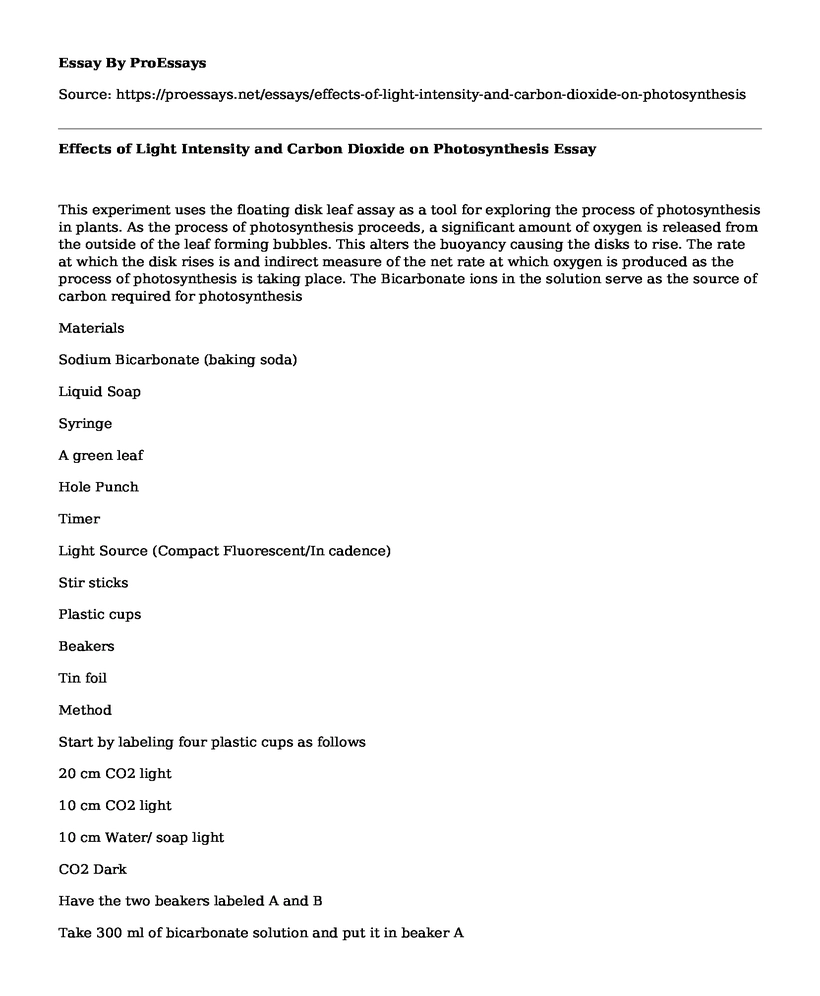This experiment uses the floating disk leaf assay as a tool for exploring the process of photosynthesis in plants. As the process of photosynthesis proceeds, a significant amount of oxygen is released from the outside of the leaf forming bubbles. This alters the buoyancy causing the disks to rise. The rate at which the disk rises is and indirect measure of the net rate at which oxygen is produced as the process of photosynthesis is taking place. The Bicarbonate ions in the solution serve as the source of carbon required for photosynthesis
Materials
Sodium Bicarbonate (baking soda)
Liquid Soap
Syringe
A green leaf
Hole Punch
Timer
Light Source (Compact Fluorescent/In cadence)
Stir sticks
Plastic cups
Beakers
Tin foil
Method
Start by labeling four plastic cups as follows
20 cm CO2 light
10 cm CO2 light
10 cm Water/ soap light
CO2 Dark
Have the two beakers labeled A and B
Take 300 ml of bicarbonate solution and put it in beaker A
To the bicarbonate solution in beaker A, add a 300 ml of water and stir.
Put 300ml of water in beaker B and add 200ml of soap solution as you stir
To beaker A, add a drop of soap solution and continue stirring as well
Hole punch 30 complete leaf disks in texture and thickness
Take out the plunger of the syringe and position ten leaf disks in the syringe barrel
Replace the plunger carefully so as to avoid crushing the leaf disk.
Draw a small amount of the infiltrate solution into the syringe from beaker A. Invert the syringe and tap the syringe to spread the leaf disks inside the infiltrate solution.
Push the plunger while drawing away as much air as you can from the syringe.
Place a finger over the syringe opening channel and draw the air.
Pour the disks and the bicarbonate solution into a marked cup
Add the infiltrate solution from beaker A until almost the cup is half full
For the first trail (the first cup named cup in step one) put the light exactly 20cm below the top of the stand. For the second and third place the light 10 cm below.
Start the timing just after exposing the leaf disks to the light
Discussion
When the leaf is exposed to light, the leaf starts to produce oxygen. As the process of photosynthesis proceeds, a significant amount of oxygen is released from the outside of the leaf forming bubbles. This alters the buoyancy causing the disks to rise. When these leaf intercellular spaces are otherwise occupied with the solution, the density of the leaf rises making the leaf to sinks. Penetrating the air spaces with the bicarbonate solution, which includes a little amount of Sodium bicarbonate, makes the total mass of the leaf disk to increases causing the disk to sink. Since the rate at which the disk rises is and indirect measure of the net rate at which oxygen is produced as the process of photosynthesis is taking place. The leaf in trial 1 sunk faster indicating that the more the light, the higher the rate of photosynthesis.
Conclusion
The rate of photosynthesis is seen to be higher when both the amount of carbon dioxide and sunlight are high.
Cite this page
Effects of Light Intensity and Carbon Dioxide on Photosynthesis. (2021, Mar 09). Retrieved from https://proessays.net/essays/effects-of-light-intensity-and-carbon-dioxide-on-photosynthesis
If you are the original author of this essay and no longer wish to have it published on the ProEssays website, please click below to request its removal:
- Legislative Approach Taken to Control Waste Water in Trinidad and Tobago and That Taken in South Korea
- Why Orca Whales Should Not Live in Captivity Essay
- Essay Example on Bioenergy: Harnessing Solar Energy Through Biomass
- Photosynthesis Experiment Paper
- Essay Example on Industrial Pollution: A Business Problem Facing Manufacturing Industries
- Reducing Climate-Related Disasters: UN's Decade-Long Effort - Essay Sample
- Gene Patents: Unlawful & Unjust? - Essay Sample







